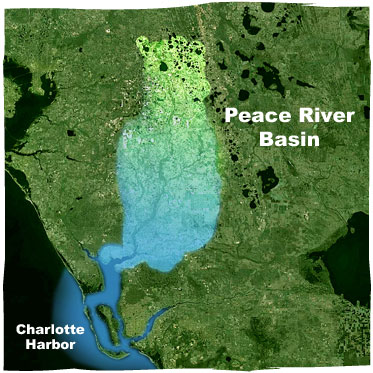The Peace River Basin

The Peace River Basin spans 105 miles from the Green Swamp to Charlotte Harbor. The majority of the river runs through “Bone Valley”, the area in central Florida where the majority of the phosphate impacts have originated.
The Peace River watershed is defined by its waters. It covers 2,300 square miles of west central Florida. The river begins in the Green Swamp and wanders by and through the loosely connected lakes and streams of Polk County. It is fed by dozens of streams and creeks as it flows 105 miles south to the Charlotte Harbor estuary.
Pine flatwoods, palmetto prairies and improved pastures are among the diverse landforms of the basin. Wetlands are also a key feature of the landscape. As natural water storage, recharge and filtering systems, the wetlands provide a vital function. Any change to the wetlands will disrupt water flows, decrease water quality, and hurt wildlife populations.
On days of adequate flow, the Peace River supplies about 6 million gallons of drinking water to residents who live in Charlotte, Sarasota and Desoto counties. Horse Creek, a major tributary of the Peace River supplies 15 percent of the river's flow upstream of the public water supply intake. Communities up and downstream rely on the flows from the Peace River to provide drinking water supplies, high-quality wildlife habitat, and support for vital industries such as fishing, agriculture and eco-tourism.
The region is part of "Bone Valley" an area rich in phosphate deposits and heavily targeted for expanded strip mining. Phosphate's history with the Peace River goes back to the beginning of mining in Florida. Phosphate was first discovered in Bone Valley in 1881 and the first phosphate was collected by hand straight from the river, before the miners moved to the land.
According to the Southwest Florida Water Management District the Peace River is already in danger of "significant harm" from reduced water flow, partly resulting from phosphate mining. Horse Creek, the next area slated for phosphate mining, is facing the same danger. There is broad concern that the proposed mining will affect the water flowing from Horse Creek, reducing the quality and quantity of water–all the way downstream.
Tourism and recreation along the Peace River Basin provide us $4.5 billion in sales. Commercial fishing adds $38 million to the economy, and agriculture adds $1.8 billion. By comparison, phosphate mining contributes $530 million. More than one million people are employed in the fishing, tourism and recreation and agriculture industries. Phosphate strip mining has fewer than 10,000 jobs statewide (3,100 promised in the Peace River watershed).